Good work, Huck, on the cannons. I have to confess that I have read about those cannons elsewhere recently, I can't remember where. But the significance of the names didn't register with me. Also, I had always assumed that those two cards came from further south, Bologna or Florence, because of the Tower in the Charles VI deck, which I assume dates from before the Steele Sermon's mention of both cards. But the Charles VI's designs may not be that old, and the two cards may well be Ferrarese. (Did I read you right, that you were suggesting that they were a Ferrarese contribution to a deck which earlier, in Milan at least, had had 20 cards at one point?) I will try to remember where else I've read about the cannons.
On alchemy and gunpowder, I have to go back and re-read Kelly. Maybe the bit about the cannons was in there.
Re: Tarot-like images in a c.1420 manuscript
12Now I am ready to get down to the business of understanding better the illustrations of Palat. 1066. First, Liebeschütz (Fulgentius Metaforalis: Ein Beitrag zur Geschichte der Antiken Mythologie im Mittelalter, Leipzig 1926, p. 56), like Panofsky, dates the manuscript at "um 1420," i.e. c. 1420.
Next, something about the text. The text has six chapters. I don't know Latin, much less medieval Latin, but I can recognize names.
Chapter I: Ydolatria.
Chapter II: Saturnus, Prudenticia. Included is Pollux (72), Minerva (74), Ops (74) Venus (78), the and the virtue sapiencia (75).
Chapter III: Iupiter, Benivolencia, including Hercules and Aries/Ares/virtus (79) and the virtues caritas (79 ff), amicicie (80ff), and others.
Chapter IV: Iuno, Memoria. This chapter includes Lucina (92) and Hercules (91)
Chapter V: Neptunus, Intelligencia. This chapter includes the Harpies (p. 97)
Chapter VI: Pluto, Providencia. This chapter includes Mercury (100), Minerva (101),Cerberus (103), Persephone/Ceres/Lucinia/Dyana (one goddess, p. 107), Orpheus (107), the Furies (108), the Fates (111), and various souls in the underworld, Tantalus etc. (103)
Apollo is nowhere mentioned except in reference to the oracle of Apollo that Socrates visited. Mercury is mentioned only in saying that Pluto went to his wedding with Philologia. (I scanned the text visually and also Liebeschütz's index, which gives these references.)
The Fulgentius Metaforalis text, for which Liebeschütz is providing a critical edition, also contains a short set of rhymed verses for each of the gods named in the chapter headings. There is also one in the first chapter, to Ydolatria herself:
My stab at translation: Woman noted, eyes bereaved, ears mutilated, horn ventilated, face deformed and sickly vexed.
In addition, the manuscript Palat. 1066, in contrast to others of Ridewall's text, contains a series of rhymed verses on other gods and legendary figures. Liebeschütz gives these in an appendix (Nachtrag) to the text, his p. 116. He prefaces them with the following remarks:
Since the verses appear to be the main source of the illustrations, I will reproduce them as I get to each illustration. I am puzzled by their origin. I do not find them in the English translation of Fulgentius. They seem medieval, like the verses of the Carmina Burana. Ridewall appears to have structured his commentary around them, but to have only dealt with six of the poems.
I have already reproduced the first illustration, f. 218v, of a bowman in a chariot, with the 9 muses: here it is again, a little smaller.

He is identified by Liebeschütz, not surprisingly, as Apollo. The verse (on 217v) reads
Checking the real Fulgentius, however, I see there is a "legend of the crow" (http://www.theoi.com/Text/FulgentiusMyt ... quote]They choose to put the crow also under Apollo’s protection...[/quote]
As for the horseman, the same text says,
So the horseman might be suggested by the account of the red-faced horse. We also have an explanation of the horses' different colors: the redder ones are for the morning and evening.
These details--the bird, the horseman, the horses--while in Fulgentius, are not usually presented in imagery about Apollo. The Libellus, below, has a bird, but it does not look black. These details in 1066 remain suspiciously alchemical in being so emphasized in their color.

The illustration of ms. 1066 also differs from the usual in putting Apollo in a chariot. Although part of his myth, and called for by the verse, a chariot is usually given to Mars rather than Apollo, as in the Libellus, similar here to the "Echecs". (Liebeschütz has kindly included in his book photos of the entire Libellus (Lat. 1290), in 15 pages, as well as a transcription of the Lain text. So I will be comparing images as we go along.)

Chariots are not usual in alchemy; they of course do have a place in the tarot.
The second image, f. 218r, which I surmised was also Apollo, is Phaeton, flying through the air and then dead in the water.
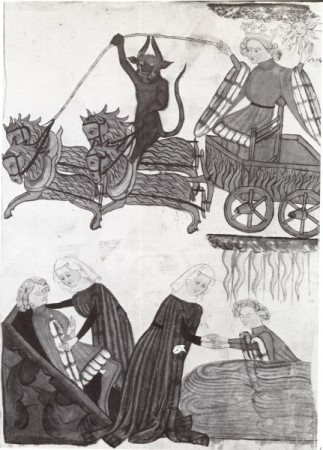
The verse reads,
Alone born (an only child?), course inflamed, place high, on course placed, letters plowed (written?), loris (armor, reins?) seized, minor trouble, troubled fear, death conceded, splendid verse, of weeping stiff.
I'm not sure which is funnier (to someone who knows Latin), these verses or my attempts at translation.
Perhaps trying to Christianize the image, the artist makes the horned figure on the horse into a devil causing the horses to veer off course. In Fulgentius, Phaeton's death is mourned by his sisters
I do not see an image of Phaeton in the Libellus.
The third, f. 223v, is Juno, as already stated.

Here is the verse:
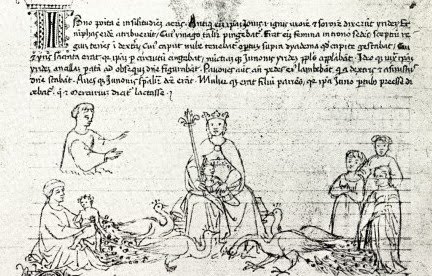
But she is the goddess of marriage, so OK. The raincloud (missing in the Libellus) indicates the "dew" of the verse. The scene could be alchemical, or not.
This hooded lady, as I have remarked before, appears over and over again. She is Juno, not Iris (as de Rola thought). But I have a theory about Juno in the 15th century. Seznec discusses a manuscript known as the "Copenhagen Commentary." He observes that
The fourth illustration, f. 224v (http://4.bp.blogspot.com/_5e7P4Y3Wo3w/T ... eagles.jpg), is Jupiter, as already stated. The eagle is his attribute, but why 8?
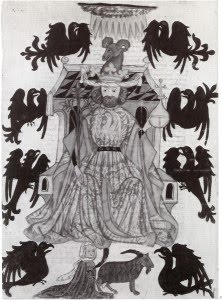
Here is the verse:
In the text, we learn that he is associated with Ares/Aries. Hence the ram at the bottom of the illustration. it might indicate his martial readiness. I see nothing about either 8 eagles or Aries/Ares in Fulgentius himself. I already showed the Libellus's image of Jupiter, on a throne with people bowing prostrate around him; here it is again:

The fifth illustration, f. 221, shows, as have seen, a king and queen sitting while around them are the three fates and other creatures, as well as a three-headed dog and a monster with a gaping mouth.

Earlier, I had not identified a god here. It turns out to be Pluto, presumably with Proserpina by his side. The other creatures are typical accompaniments of this god, as can be seen by the Libellus image of the same god.

The dog is of course Cerberus; the three creatures having bad hair days are likely the Furies, whom Ridewall associates with Pluto. Here is the verse:
Here I go again: wood-crowned, riches-controlled, prelate below, Cerberus tasted, Etati (?) imprisoned, Furies armed, and Fates entrenched.
Without other context, there is nothing alchemical about either image. However in context of the other images in Palat. 1066, the scene also suggests the Putrefactio, since it has a king and queen in an enclosed space. The Libellus has no such suggestion.
The sixth, f. 222v, is the man standing naked under a rain cloud, interacting with the hooded lady.
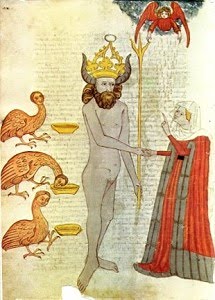
I had not identified the god. It is supposed to be Neptune. However the only familiar attribute of his is the trident. In the Libellus he has a horse and maritime trumpeters.

Here is the verse.
Yes, Styx was a goddess, although I have never heard before that she was married to Neptune. Wikipedia has her married to Pallas. In any case, we know where the horns come from now: "cornutas" Thus the artist dutifully makes Neptune both "cornutas" and "coronatus." I had never heard of a Neptune with horns, but apparently Roman mosaics in England did picture him that way (http://penelope.uchicago.edu/Thayer/E/G ... E/12*.html). Ridewall was English, after all, and this verse is one of those that appear in his text.
The seventh, 226r, is another I have already shown. It is of Saturn and his castration.


The Libellus version is similar, but not quite as anatomically detailed, and does not include the lower scene of Jupiter giving the genitalia to the children. The verse reads,
"Opi" means "abundance" and is a name of Rhea (http://en.wikipedia.org/wiki/Ops).
The eighth, f. 227r, is Mercury, as already stated.
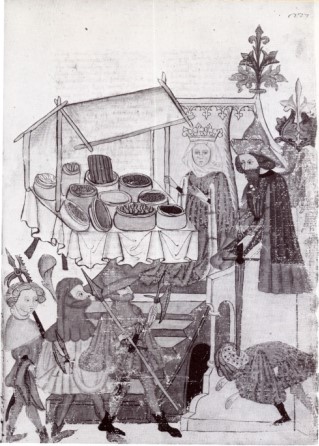
It still has its puzzling aspects, namely, the lady and the table with its pots. The verse:
I doubt if any of this explains the pots. The Libellus image has no such table (although at least Mercury has a weapon, missing from the "echecs" image we saw in my previous post).

I have a theory, namely, that the artist conflated Mercury and Esclepius. In the Libellus, Asclepius has his snake-entwined staff and a table full of medicines.

Such a conflation would suggest an affinity with alchemy; these particular children of Hermes (Trismegistus) who experimented with chemical medicines, including the use of mercury and other poisons in small doses.(To be sure, the Libellus's Aesclepius is mainly interested in herbs.) The Greek god Mercury had no such inclinations.
I notice that the table in 1066 is drawn with inverse perspective, i.e. the vanishing point in front of the picture-plane instead of behind. The "Marseile" Bateleur's table is similar (and to a less extent, the "Cary Sheet's}), as SteveM pointed out on the "Bateleur" thread (viewtopic.php?f=23&t=384&p=6870&hilit=inverse#p6870 and his next post).
The ninth picture, f. 228r, has Danae at the top, in the illustration I have already shown in a poorer reproduction, with the verse already quoted. Like all the rest so far, it could be alchemical but doesn't have to be. At the bottom is Alcestis. Here are both.
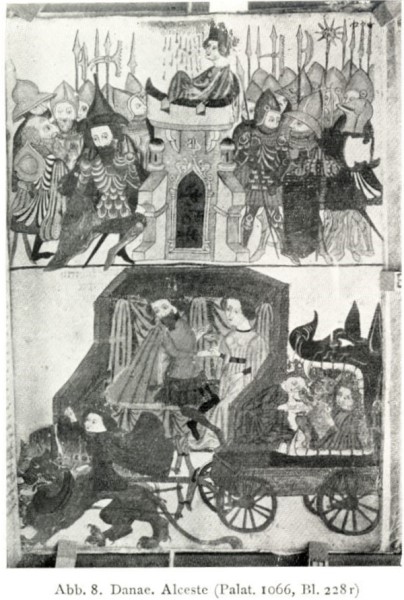
I am struck by the resemblance of the drapery behind Alcestis and her husband to that behind the royal figures in the early tarot. Again, this could be alchemical, the mortificatio. Hell is a dog's mouth, like the opening of an alchemical furnace.
The verse is as follows: "A rege postulata, regi copulata, precio donata, facie venundata, infernis allata, Hercule salutata.[/quote]
From a king requested, of that king coupled, gave the price, face veiled (?), went below, Hercules visited.
Alcestis of course volunteered to go to Hades in her husband's place, a model of wifely devotion--or continence, according to Liebeschütz's chart of virtues associated with her.
The tenth, f. 229r, is new to us. It has the death of Priam on top and Paris, with the three goddesses, at the bottom. The scene with Paris is unusual in that two bulls or rams are locking horns. It suggests Troy and Greece. But scenes of two similar animals contending like that are common in alchemy; usually they are lions, eagles, or canines.
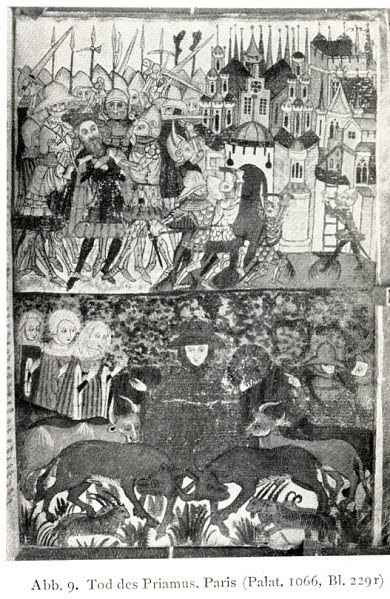
The verse goes
Paris of course went to Sparta to negotiate a peace treaty, then eloped with the other signator's wife; the Trojan War ensued.
The eleventh, f. 230r, is of Minerva, Juno, and Venus, the three goddesses we met with Paris (http://3.bp.blogspot.com/_5e7P4Y3Wo3w/T ... th230v.jpg). They represent the contemplative, active, and luxurious life respectively, according to the annotations.
Here is what is written for Minerva (with Liebeschütz's comment, "Die Zusammenfassung der Attribute im Reim fehlt hier"--the putting together of attributes in rhyme fails here): 1) generata de vertice Jovis. 2) in etate juvenili. 3) veste variata. 4) cum galea in capite. 5) cristata. 6)signata stella arietis. 7) caput gorgonis in scuto. 8) a Volcano petita. 9) attribuunt ei avem noctuam. 10) fuit in alta turri collacata. 11) portat hastam. 12) sibi consecratur palma.[/quote]
Born from the head of Jove. In a youthful state, variously clothed, with a helmet on her head, plumed, marked with a star ..., gorgon's head on shield, inclined to a Volcano?, attribute is nocturnal bird, put in a high tower, carries a spear, palm consecrated to.
That explains much of the imagery. Here she is:
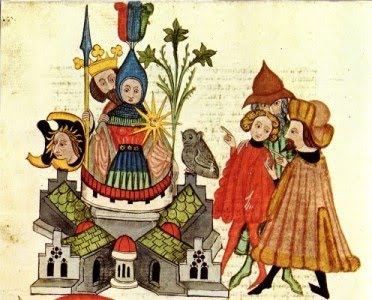
But why the king, unless he is to be killed, as in the alchemical scenario. I am reminded of this illustration in the Dresden copy of the Buch der Heilegen Dreifaltigkeit , from the same era as our illustrations, But I don't know exactly when this illustration became current; (I get this from http://www.handschriftencensus.de/14918, a link that Huck provided on another thread, many thanks.)

In contrast, the Libellus's image is more standard, similarly in the "Echecs." No king and no alchemical-like container in which both are put.
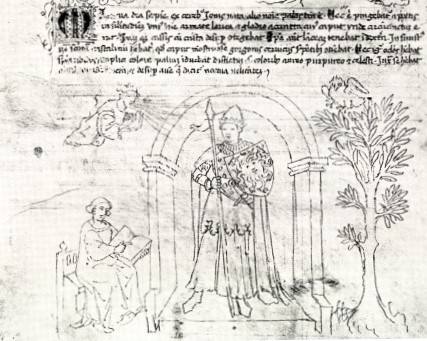
Next is Juno:
Yes, that fits so far.
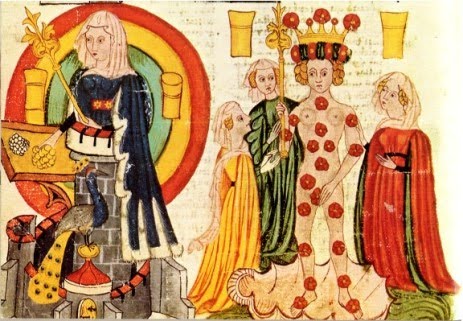
And Venus's verse:
So we have an explanation for the roses all over her body: it's what she is dressed in.
But again these images--as well as the descriptions in the verses--are unusual. The Libellus's Juno (earlier in this post) has no piles of coins, no tower in which she is put. Yet in her myth, according to Wikipedia, she was the patroness of the Roman mint and had the epithet "Juno Moneta," meaning "Protector" rather than money (http://en.wikipedia.org/wiki/Juno_(mythology)).
Likewise, the Libellus's Venus (like the similar Echecs) is not clothed in roses, or even on a shell.

I for one have never seen a such a rose-speckled Venus as the one in 1066's illustration. De Rola's interpretation, that it is the heated substance's change in appearance, is no stranger.
That concludes the 1066's sequence of gods and legendary figures. Next come the virtues and vices, 13 pages of illustrations, of which some are unusual and of interest here. But I will stop for now. In general, I think the details I have presented, with your patience, only continue to make the images ambiguous. There are still some details that the verses don't justify, like the hooded lady's manifold appearances and the "trash cans," as I have called them. And the verses that partially justify the strange details are themselves mostly peculiar to this manuscript, or so it seems to me. The worlds of the gods, of alchemy, and the tarot are all here, in a kind of protean soup, unlike any other set of illustrations I have seen from that era.
Next, something about the text. The text has six chapters. I don't know Latin, much less medieval Latin, but I can recognize names.
Chapter I: Ydolatria.
Chapter II: Saturnus, Prudenticia. Included is Pollux (72), Minerva (74), Ops (74) Venus (78), the and the virtue sapiencia (75).
Chapter III: Iupiter, Benivolencia, including Hercules and Aries/Ares/virtus (79) and the virtues caritas (79 ff), amicicie (80ff), and others.
Chapter IV: Iuno, Memoria. This chapter includes Lucina (92) and Hercules (91)
Chapter V: Neptunus, Intelligencia. This chapter includes the Harpies (p. 97)
Chapter VI: Pluto, Providencia. This chapter includes Mercury (100), Minerva (101),Cerberus (103), Persephone/Ceres/Lucinia/Dyana (one goddess, p. 107), Orpheus (107), the Furies (108), the Fates (111), and various souls in the underworld, Tantalus etc. (103)
Apollo is nowhere mentioned except in reference to the oracle of Apollo that Socrates visited. Mercury is mentioned only in saying that Pluto went to his wedding with Philologia. (I scanned the text visually and also Liebeschütz's index, which gives these references.)
The Fulgentius Metaforalis text, for which Liebeschütz is providing a critical edition, also contains a short set of rhymed verses for each of the gods named in the chapter headings. There is also one in the first chapter, to Ydolatria herself:
Mulier notata, oculis orbata, aure mutilata, cornu ventilata, vultu deformata et morbo vexata.
My stab at translation: Woman noted, eyes bereaved, ears mutilated, horn ventilated, face deformed and sickly vexed.
In addition, the manuscript Palat. 1066, in contrast to others of Ridewall's text, contains a series of rhymed verses on other gods and legendary figures. Liebeschütz gives these in an appendix (Nachtrag) to the text, his p. 116. He prefaces them with the following remarks:
("We give here, finally, the pictures for the chapters of Fulgentius in Palatinus 1066 that are not dealt with in the oldest Ridewall version, and in addition print the descriptive verses in the same manuscript." Is that it? I get lost re-arranging the German phrases into English.)Wir geben hier schliesslich die Bilder zu den in der ältesten Ridewallfassung nicht bearbeiteten Fulgentiuskapiteln nach den Palatinus 1066, und drucken dazu die Beschreibungsverse nach der gleichen Handschrift ab:
Since the verses appear to be the main source of the illustrations, I will reproduce them as I get to each illustration. I am puzzled by their origin. I do not find them in the English translation of Fulgentius. They seem medieval, like the verses of the Carmina Burana. Ridewall appears to have structured his commentary around them, but to have only dealt with six of the poems.
I have already reproduced the first illustration, f. 218v, of a bowman in a chariot, with the 9 muses: here it is again, a little smaller.

He is identified by Liebeschütz, not surprisingly, as Apollo. The verse (on 217v) reads
Youth armed, horns unplowed (?), four horses unconcealed, horseman aroused, crown with gems, letters ploughed (written?), muses-attended. Whatever is said that I didn't get, there is nothing about the horseman being red or the black bird, which were the main suggestions of alchemy.Iuvenis armatus, cornis dearatus, quadriga delatus, equis agitatus, gemmis coronatus, litteris aratus, musis ministratus.
Checking the real Fulgentius, however, I see there is a "legend of the crow" (http://www.theoi.com/Text/FulgentiusMyt ... quote]They choose to put the crow also under Apollo’s protection...[/quote]
As for the horseman, the same text says,
They also assign to him a four-horse chariot, for the reason that either he goes through the cycle of the year in the four changes of the seasons or he divides up the space of the day into a fourfold division. From this they have given the steeds these appropriate names: Erythraeus, Actaeon, Lampus, and Philogeus. Erythraeus is the Greek for blushing red, because he rises red-faced on the threshold of dawn; Actaeon means resplendent, because he flashes the more brightly as he impetuously pursues the turning posts of his track; Lampus is burning, because he mounts the track towards reaching the midpoint of day; and Philogeus in Greek is called loving the earth because, bending forwards towards the ninth hour, he inclines to his setting.
So the horseman might be suggested by the account of the red-faced horse. We also have an explanation of the horses' different colors: the redder ones are for the morning and evening.
These details--the bird, the horseman, the horses--while in Fulgentius, are not usually presented in imagery about Apollo. The Libellus, below, has a bird, but it does not look black. These details in 1066 remain suspiciously alchemical in being so emphasized in their color.

The illustration of ms. 1066 also differs from the usual in putting Apollo in a chariot. Although part of his myth, and called for by the verse, a chariot is usually given to Mars rather than Apollo, as in the Libellus, similar here to the "Echecs". (Liebeschütz has kindly included in his book photos of the entire Libellus (Lat. 1290), in 15 pages, as well as a transcription of the Lain text. So I will be comparing images as we go along.)

Chariots are not usual in alchemy; they of course do have a place in the tarot.
The second image, f. 218r, which I surmised was also Apollo, is Phaeton, flying through the air and then dead in the water.

The verse reads,
Sole generatus, curru inflammatus, situ sublimatus, in curru locatus, litteris aratus, loris occupatus, mole minoratus, timore turbatus, morti concempnatus, versibus ornatus, fletibus rigatus.
Alone born (an only child?), course inflamed, place high, on course placed, letters plowed (written?), loris (armor, reins?) seized, minor trouble, troubled fear, death conceded, splendid verse, of weeping stiff.
I'm not sure which is funnier (to someone who knows Latin), these verses or my attempts at translation.
Perhaps trying to Christianize the image, the artist makes the horned figure on the horse into a devil causing the horses to veer off course. In Fulgentius, Phaeton's death is mourned by his sisters
But I have never seen a Phaeton helped out of the water like that and then helped into a tomb. It is reminiscent of both alchemical entombment and the Judgment card.His sisters are Arethusa and Lampethusa, who bemourn their brother’s destruction by fire with bejeweled and gleaming drops, and shed golden amber from their torn barks.
I do not see an image of Phaeton in the Libellus.
The third, f. 223v, is Juno, as already stated.

Here is the verse:
Head-veiled, rainbow-wreathed, perfume-fanned, sceptor-decorated and gold-bound, Jove-espoused, Hercules-enraged, birds-surrounded, dew-moistened, and light-illuminated. (translation after that in Seznec, which I have adjusted to correspond word for word with the Latin). I see now the "golden chain," Seznec's translation of "auro ligata." It is the sash around her waist. The Latin has nothing about a chain (although Fulgentius himself does):Vertice velata, iride sertata, unguentis afflata, sceptro decorata et auro ligata, Iovi maritata, Herculi irata, avibus vallata, humore rigata et luce lustrata.
The artist has chosen to illustrate the verse, which is less specific. There is still nothing so far about the two people she is standing between. The Libellus, for example, has no such couple in its illustration of Juno.For both Theopompus in his Cyprian poem and Hellanicus in the Dios politia written by him declare that Juno was bound by Jove with golden chains and weighed down with iron fetters...

But she is the goddess of marriage, so OK. The raincloud (missing in the Libellus) indicates the "dew" of the verse. The scene could be alchemical, or not.
This hooded lady, as I have remarked before, appears over and over again. She is Juno, not Iris (as de Rola thought). But I have a theory about Juno in the 15th century. Seznec discusses a manuscript known as the "Copenhagen Commentary." He observes that
In the case of ms. Palat. 1066, Juno might, as the Church incarnate, represent a mystegogue who accompanies everyman--the King--in his journey through life and its various initiations. In the tarot, Juno later sometimes took the place of the Popess. There, the Popess would be a similar female psychopomp, perhaps also reappearing later in the sequence--in the "Marseille" Lovers card, Justice, Wheel (the unseen turner), Strength, Temperance, and finally in new guises in the Star, Moon, Judgment, and World.As Jeannette van't Sant has discerningly remarked (footnote: Le Commentaire de Copenhague de l'Ovide morlise, p. 12), it sometimes happens that the aurhor of the Commentaire strays from moral interpretation into the realm of social criticism. In fact, the mythological divinities by no means always symbolize for him vice in general, but suggest the views of his own time, and above all the vices of the great--of clergy and princes. Pluto, for example, incarnates the evil prelate; Mars and Neptune, earthly tyrants. In contrast, Saturn, Jupiter, and Apollo upon occasion represent the virtuous ecclesiastic. As for Juno, she remains the incarnation of the Church. (Survival of the Pagan Gods, p. 93f).
The fourth illustration, f. 224v (http://4.bp.blogspot.com/_5e7P4Y3Wo3w/T ... eagles.jpg), is Jupiter, as already stated. The eagle is his attribute, but why 8?

Here is the verse:
Head bent, ..., eagle or eagles (?) attending, with palm scepter, gold garment, countenance is amenus (agreeable?) and of serene color, spear-bearing and an animal horn.Vertice curvatus, arena loctatus, aquilis stipatus, cum palma sceptratus, auro velatus, vultus est amenus et color serenus; fulmen iaculatur et cornu cibatur.
In the text, we learn that he is associated with Ares/Aries. Hence the ram at the bottom of the illustration. it might indicate his martial readiness. I see nothing about either 8 eagles or Aries/Ares in Fulgentius himself. I already showed the Libellus's image of Jupiter, on a throne with people bowing prostrate around him; here it is again:

The fifth illustration, f. 221, shows, as have seen, a king and queen sitting while around them are the three fates and other creatures, as well as a three-headed dog and a monster with a gaping mouth.

Earlier, I had not identified a god here. It turns out to be Pluto, presumably with Proserpina by his side. The other creatures are typical accompaniments of this god, as can be seen by the Libellus image of the same god.

The dog is of course Cerberus; the three creatures having bad hair days are likely the Furies, whom Ridewall associates with Pluto. Here is the verse:
Ligno coronatus, opibus dictatus, inferis prelatus, Cerbero delatus, Etati ligatus, Furiis armatus, et Fatis vallatus.
Here I go again: wood-crowned, riches-controlled, prelate below, Cerberus tasted, Etati (?) imprisoned, Furies armed, and Fates entrenched.
Without other context, there is nothing alchemical about either image. However in context of the other images in Palat. 1066, the scene also suggests the Putrefactio, since it has a king and queen in an enclosed space. The Libellus has no such suggestion.
The sixth, f. 222v, is the man standing naked under a rain cloud, interacting with the hooded lady.

I had not identified the god. It is supposed to be Neptune. However the only familiar attribute of his is the trident. In the Libellus he has a horse and maritime trumpeters.

Here is the verse.
Horned, exuding riches, harpy-served, stature inclined and sickly grave, ..., trident-sceptered, married to Styx.Cornutus, opibus exutus, Arpiis adiutus, statura levatus et mole gravatus, canicie delbatus, sale coronatus, tridente sceptrizatus, Stigi maritatus.
Yes, Styx was a goddess, although I have never heard before that she was married to Neptune. Wikipedia has her married to Pallas. In any case, we know where the horns come from now: "cornutas" Thus the artist dutifully makes Neptune both "cornutas" and "coronatus." I had never heard of a Neptune with horns, but apparently Roman mosaics in England did picture him that way (http://penelope.uchicago.edu/Thayer/E/G ... E/12*.html). Ridewall was English, after all, and this verse is one of those that appear in his text.
The seventh, 226r, is another I have already shown. It is of Saturn and his castration.


The Libellus version is similar, but not quite as anatomically detailed, and does not include the lower scene of Jupiter giving the genitalia to the children. The verse reads,
Opi-married, old man-sick, head covered and sickle-sceptered, aspect-forsaken, genitalia-bereaved and children-food.Opi maritatus, senio gravatus, capite velatus et falce sceptratus, vultu desolatus, pudendis orbatus et prole cibatus.
"Opi" means "abundance" and is a name of Rhea (http://en.wikipedia.org/wiki/Ops).
The eighth, f. 227r, is Mercury, as already stated.

It still has its puzzling aspects, namely, the lady and the table with its pots. The verse:
Double-sexed, in motion, ... bound, fruitful warrior (or prelate), ..., emissary of peace.Sexu bissulcatus, alis agitatus, frenesi ligatus, cede cruentatus, meribus vallatus, fructibus prelatus, pilleo velatus et pacis legatus.
I doubt if any of this explains the pots. The Libellus image has no such table (although at least Mercury has a weapon, missing from the "echecs" image we saw in my previous post).

I have a theory, namely, that the artist conflated Mercury and Esclepius. In the Libellus, Asclepius has his snake-entwined staff and a table full of medicines.

Such a conflation would suggest an affinity with alchemy; these particular children of Hermes (Trismegistus) who experimented with chemical medicines, including the use of mercury and other poisons in small doses.(To be sure, the Libellus's Aesclepius is mainly interested in herbs.) The Greek god Mercury had no such inclinations.
I notice that the table in 1066 is drawn with inverse perspective, i.e. the vanishing point in front of the picture-plane instead of behind. The "Marseile" Bateleur's table is similar (and to a less extent, the "Cary Sheet's}), as SteveM pointed out on the "Bateleur" thread (viewtopic.php?f=23&t=384&p=6870&hilit=inverse#p6870 and his next post).
The ninth picture, f. 228r, has Danae at the top, in the illustration I have already shown in a poorer reproduction, with the verse already quoted. Like all the rest so far, it could be alchemical but doesn't have to be. At the bottom is Alcestis. Here are both.

I am struck by the resemblance of the drapery behind Alcestis and her husband to that behind the royal figures in the early tarot. Again, this could be alchemical, the mortificatio. Hell is a dog's mouth, like the opening of an alchemical furnace.
The verse is as follows: "A rege postulata, regi copulata, precio donata, facie venundata, infernis allata, Hercule salutata.[/quote]
From a king requested, of that king coupled, gave the price, face veiled (?), went below, Hercules visited.
Alcestis of course volunteered to go to Hades in her husband's place, a model of wifely devotion--or continence, according to Liebeschütz's chart of virtues associated with her.
The tenth, f. 229r, is new to us. It has the death of Priam on top and Paris, with the three goddesses, at the bottom. The scene with Paris is unusual in that two bulls or rams are locking horns. It suggests Troy and Greece. But scenes of two similar animals contending like that are common in alchemy; usually they are lions, eagles, or canines.

The verse goes
My guess: Born of a king, shepherd of flocks, ambassador ..., lover's reward.Natus regis, pastor gregis, lator legis, amator mercedis.
Paris of course went to Sparta to negotiate a peace treaty, then eloped with the other signator's wife; the Trojan War ensued.
The eleventh, f. 230r, is of Minerva, Juno, and Venus, the three goddesses we met with Paris (http://3.bp.blogspot.com/_5e7P4Y3Wo3w/T ... th230v.jpg). They represent the contemplative, active, and luxurious life respectively, according to the annotations.
Here is what is written for Minerva (with Liebeschütz's comment, "Die Zusammenfassung der Attribute im Reim fehlt hier"--the putting together of attributes in rhyme fails here): 1) generata de vertice Jovis. 2) in etate juvenili. 3) veste variata. 4) cum galea in capite. 5) cristata. 6)signata stella arietis. 7) caput gorgonis in scuto. 8) a Volcano petita. 9) attribuunt ei avem noctuam. 10) fuit in alta turri collacata. 11) portat hastam. 12) sibi consecratur palma.[/quote]
Born from the head of Jove. In a youthful state, variously clothed, with a helmet on her head, plumed, marked with a star ..., gorgon's head on shield, inclined to a Volcano?, attribute is nocturnal bird, put in a high tower, carries a spear, palm consecrated to.
That explains much of the imagery. Here she is:

But why the king, unless he is to be killed, as in the alchemical scenario. I am reminded of this illustration in the Dresden copy of the Buch der Heilegen Dreifaltigkeit , from the same era as our illustrations, But I don't know exactly when this illustration became current; (I get this from http://www.handschriftencensus.de/14918, a link that Huck provided on another thread, many thanks.)

In contrast, the Libellus's image is more standard, similarly in the "Echecs." No king and no alchemical-like container in which both are put.

Next is Juno:
.something about riches,.., clothed in gold, ..., rainbow-illuminated, head veiled, in a high spot, ungents...diviciis vel opibus ditata, viribus orbata, vestibus aurata, pavone curata, yride lustrata, capite velata, in sublimi sita, ungentis linita.
Yes, that fits so far.

And Venus's verse:
Body nude, ...., ..., dressed in flowers, ungents blowing or ..., Graces-attended, and shell-emplaced.corpore nudata, equore delata, virore plantata, cute dealbata, floribus ornata, ungentis afflata vel linita, gracijs stipata et concha locata.
So we have an explanation for the roses all over her body: it's what she is dressed in.
But again these images--as well as the descriptions in the verses--are unusual. The Libellus's Juno (earlier in this post) has no piles of coins, no tower in which she is put. Yet in her myth, according to Wikipedia, she was the patroness of the Roman mint and had the epithet "Juno Moneta," meaning "Protector" rather than money (http://en.wikipedia.org/wiki/Juno_(mythology)).
Likewise, the Libellus's Venus (like the similar Echecs) is not clothed in roses, or even on a shell.

I for one have never seen a such a rose-speckled Venus as the one in 1066's illustration. De Rola's interpretation, that it is the heated substance's change in appearance, is no stranger.
That concludes the 1066's sequence of gods and legendary figures. Next come the virtues and vices, 13 pages of illustrations, of which some are unusual and of interest here. But I will stop for now. In general, I think the details I have presented, with your patience, only continue to make the images ambiguous. There are still some details that the verses don't justify, like the hooded lady's manifold appearances and the "trash cans," as I have called them. And the verses that partially justify the strange details are themselves mostly peculiar to this manuscript, or so it seems to me. The worlds of the gods, of alchemy, and the tarot are all here, in a kind of protean soup, unlike any other set of illustrations I have seen from that era.
Re: Tarot-like images in a c.1420 manuscript
13Well, that's nice ...
I try to analyze (first the parts, which have known already representation):
This we have from the Vatican manuscript (20 figures with an Hercules extension)
# Saturnus / Jupiter - 1r ... Saturnus is missed in the Michelino deck
# Mars / Apollo - 1v
# Venus / Mercury - 2r
# Diane / Minerva - 2v
# Pan / Pluto - 3r ... both are missed in Michelino deck
# Juno / Cybele - 3v ... Cybele is missed in Michelino deck /it's not missing, if Cybele = Ceres
# Eolus / Janus - 4r ... both are missed in echecs amoureux / Janus is missed in Michelino deck
# Vulcan / Neptun - 4v ... Vulcan is missed in Michelino deck
# Vesta / Orpheus - 5r ... both are missed in echecs amoureux / Orpheus is missed in Michelino deck
# Bacchus / Aesculapius - 5v ... Aesculapius is missed in Michelino deck
followed by an extension with the Hercules story
Comparing it with the 16 figures of the echecs amoureux, then just two pairs are lost - "Eolus /Janus" and "Vesta / Orpheus". Comparing the rows, we have changes in the latter part.
# 05 - Saturn ... identical in row
# 06 - Jupiter ... identical in row
# 07 - Mars ... identical in row
# 08 - Apollon ... identical in row
# 09 - Venus ... identical in row
# 10 - Mercury ... identical in row
# 11 - Diane... identical in row
# 12 - Pallas ... identical in row
# 13 - Juno
# 14 - Neptun
# 15 - Pluto
# 16 - Cybele
# 17 - Vulcan
# 18 - Bacchus
# 19 - Aesculapius
# 20 - Pan
For the Michelino deck we have, that 8 figures of the 20-figures Vatican manuscript are missing:
Saturn ... 1st pair
Pan-Pluto ... 5th pair
Cybele ... 6th pair, but if Cybele = Ceres, than Cybele is not missing
Janus ... 7th pair
Vulcan ... 8th pair
Orpheus ... 9th pair
Aesculapius ... 10th pair
... instead of these the Michelino deck adds 12 Ceres, 13 Hercules, 15 Daphne, 16 Eros
The row the Michelino deck:
1 Jupiter
2 Juno
3 Pallas = Minerva
4 Venus
5 Apollo
6 Neptun
7 Diana
8 Bacchus
9 Mercury
10 Mars
11 Vesta
12 Ceres
13 Hercules
14 Eolus
15 Daphne
16 Cupido
***********************************************
There's a relative clear relationship between the Vatican manuscript and the echecs amoureux:
Evrart da Conty needed 16 figures (he wanted to relate the gods to chess), so he just skipped two pairs - that's a rather simple step. Also he used as basic orientation the Chaldean row of the planets ... as the Vatican manuscript ... with Minerva as the 8th figure.
With the remaining figures he tried another row, likely inspired by the 4 elements idea:
(12 Minerva)
13 Juno = air
14 Neptun = water
15 Pluto = fire
16 Cybele = earth
... which we finally also find in Lazzarelli's interpretation in his 27 pictures:
(23 Philosophia = Minerva)
24 Juno = air
25 Neptun = water
26 Pluto = fire
27 Victoria = earth
and in the Minchiate with the cards 20-23 just as "4 elements"
Why he presented the rest ..
# 17 - Vulcan
# 18 - Bacchus
# 19 - Aesculapius
# 20 - Pan
.. in this order, stays for the moment his mystery ... or? Well, he needed 16 figures, this was his motif. If we compare the common Cessolis chess iconography, then we have between the 8 pawns
a Smith = Vulcan ? - knight pawn (king's side)
an Innkeeper = Bacchus ? - bishop pawn (queen's side)
a Physician = Aesculapius ? - Queen's pawn
a Farmer = Pan ? - rooks pawn (king's side)
That looks astonishingly symmetrical and "with intended idea", if we conclude from this, that under this somehow fitting condition then must be ...
Pluto = Doorkeeper (knight pawn mirroring the Smith - queen's side')
Neptun = Barber (bishop pawn mirroring the Innkeeper - king's side)
Juno as the king's pawn (usually an Advocat or Merchant)
Cybele as the messenger (rook pawn mirroring the farmer)
... then this might be it.
Then we would have the 7 planetary gods and Minerva as the chess officers.
*************************
This is promising ... ')
')
If we now look at the comparison Michelino deck and Vatican manuscript we have, that Martiano dropped the 5th pair of the Vatican manuscript ...
Pan and Pluto
... completely. Regarding this under the aspect, that the theme is "Chess", then we have that "the Death of chess figures" is naturally part of the game, but if a figure meets "death on the board", it's taken from the board, so "Death" is outside and not a figure.
From the later Chess deck versions (Charles VI deck) it seems, that the card "Death" was associated to a "bad knight figure (with the counterpart "triumphal chariot" as the good knight), but it's clearly an argument, that Death is not a figure at the board.
So Martiano is understandable, when he drops the pair.
From the following pairs 6-10 he takes one into the group, and drops the other.
2 Juno wins against Cybele
13 Eolus wins against Janus
6 Neptun wins against Vulcan
11 Vesta wins against Orpheus
8 Bacchus wins against Aesculapius
... well, this might have been the way of Martiano, if we could assume, that Martiano knew about the order in the Vatican manuscript, but it doesn't look VERY related.
Far more deciding seems the point, that Martiano used the system of the "12 Olympic gods" for the first 12 positions in his system ... The Manilius manuscript was found in Constance by Poggio, and Poggio had been after the council with the papal entourage in Milan (so short before the Michelino deck was constructed) ... and the Manilius system ALSO used the 12 Olympian gods. Although Martiano in his version of the Olympian gods replaced Vulcan against Bacchus, it seems very plausible, that the Michelino deck was influenced by the detection of Constance (or one has to assume, that the 12 Olympian gods were already a well known concept, but this seems a doubtful idea ... at least it should be proven, that this was so).
The similarity of the Michelino deck to the Vatican manuscript lies in the fact, that a Hercules version "was added" with Hercules - Eolus - Daphne - Amor ... though, not really a "Hecules version", but possibly inspired by Petrarca ideas.
*************************
... ... now you come with your new input.
... now you come with your new input.
I find at
http://www.theoi.com/Text/FulgentiusMythologies1.html#1
a structure of the text, which gives this content:
I started to read the introduction, which somehow is rather impressive. It takes the first half of the first book. Fulgentius meets Kalliope.
The the system starts with "Ydolotria" and then really with ...
... Saturn:
Ceres is later mentioned as mother of Proserpina:
About "Pollus" I get the information from the web, that there was a big Saturnus temple in Rome and a big Castor and Pollux temple nearby.
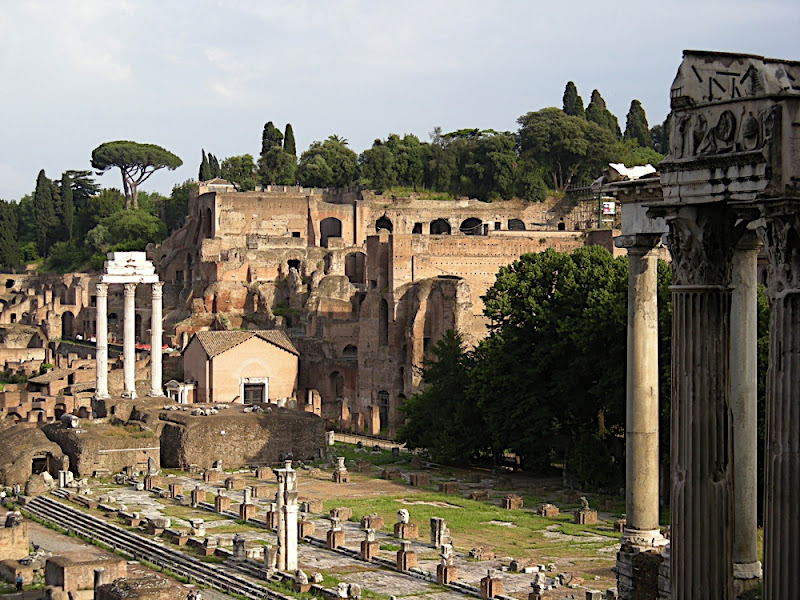
Gosh ... I should have read this earlier.
Somehow the good old Hesiod interpretation of Greek mythology was rather slaughtered with Fulgentius and likely earlier.
And here we have the answer to some good old Tarot questions ..
Why is 35 Gemini the highest numbered trump below the 5 Aries in Minchiate?
I guess, this is answered now. Gemini shows Castor and Pollux.
Also the question of the wedding between Costanzo Sforza and Camilla d'Aragon in 1475. Why did Castor and Pollux got such a preferred position in the festivity?
viewtopic.php?f=11&t=418&hilit=camilla+aragon
... somehow in this thread
And for the Minchiate and Pollus as father of the elements:
36-40 Aries (usual Tarot elements)
24-35 Zodiac with reigning Gemini
20-23 elements
16-19 four additional virtues
1-15 usual Tarot elements till lightning.
And the problem appears also in the analyzes of the Lorenzo Spirito text:
search.php?t=442
... and we have a general twin-pairing models in the 15th century, which appears in Sola-Busca, Boiardo Tarocchi, also in biographical presentations.
****************
Well, this is really shocking ...
... Vesta isn't mentioned in the whole Fulgentius. In the Manilius text (c. 20 AD) the identification between Hestia and Vesta is clearly done then, but it seems to play no role for Fulgentius. The Vesta temple in Rome had been perhaps the most important place in Rome, but in Fulgentius time (5th / 6th century) he found a reason not to mention her in his work. Perhaps this is the reason, mentioned in his dialog with Calliope, his inspiring muse:
Fulgentius is given as having lived (probably) in Northern Africa, not in Rome. Perhaps this is another explanation, why Vesta is missing.
http://en.wikipedia.org/wiki/Fabius_Pla ... Fulgentius
Fulgentius gives then Jupiter, Juno, Neptun and Pluto as elements:
Jupiter = Fire
Juno = Air
Neptun = Water
Pluto = Earth
This is in contradiction to that, what I gave earlier as the probable identification of Lazzarelli's elements:
Juno = Air
Neptun = Water
Pluto = Fire ???? or Earth ?
Victory = Earth ???? or Fire ?
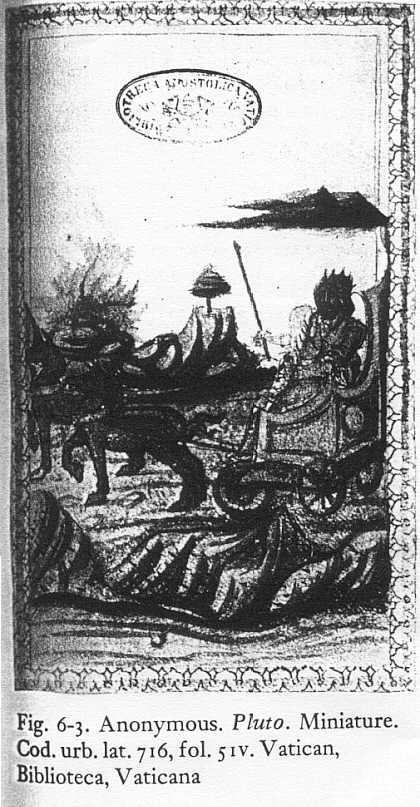
Pluto seems to have fire in the background
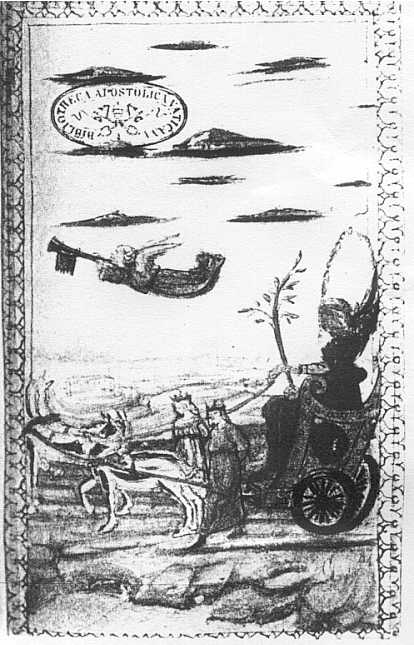
Victory ... earth is not very convincing, but there is no fire
For the earlier echecs amoureux I assumed this ...
(12 Minerva)
13 Juno = air
14 Neptun = water
15 Pluto = fire ???? or Earth?
16 Cybele = earth ???? or Fire?
... but the same problem ...
So perhaps I should first research the text ???? Do I find it ? ...there it is ...
This is the complete PLUTO (Juno was before connected air and Naptun to Water) ... ... I would assume, Lazzarelli felt the same problem and wouldn't like to contradict Fulgentius. He saved his ass and said nothing wrong.
... I would assume, Lazzarelli felt the same problem and wouldn't like to contradict Fulgentius. He saved his ass and said nothing wrong.
Victory is a rather long chapter and indeed once the word EARTH is used ...
Checking Juno's text again, I find:
I checked Juppiter's chapter (cause Fulgentius gave Fire as Juppiter) and found, that the lightning is naturally mentioned, but no attribution to the element fire.
Enough of the surprises for today ...
*****************
I've to add this:
http://trionfi.com/0/m/11
An article, which tells, that Lazzarelli and the Mantegna Tarocchi followed the Muses order of Fulgentius.
I try to analyze (first the parts, which have known already representation):
This we have from the Vatican manuscript (20 figures with an Hercules extension)
# Saturnus / Jupiter - 1r ... Saturnus is missed in the Michelino deck
# Mars / Apollo - 1v
# Venus / Mercury - 2r
# Diane / Minerva - 2v
# Pan / Pluto - 3r ... both are missed in Michelino deck
# Juno / Cybele - 3v ... Cybele is missed in Michelino deck /it's not missing, if Cybele = Ceres
# Eolus / Janus - 4r ... both are missed in echecs amoureux / Janus is missed in Michelino deck
# Vulcan / Neptun - 4v ... Vulcan is missed in Michelino deck
# Vesta / Orpheus - 5r ... both are missed in echecs amoureux / Orpheus is missed in Michelino deck
# Bacchus / Aesculapius - 5v ... Aesculapius is missed in Michelino deck
followed by an extension with the Hercules story
Comparing it with the 16 figures of the echecs amoureux, then just two pairs are lost - "Eolus /Janus" and "Vesta / Orpheus". Comparing the rows, we have changes in the latter part.
# 05 - Saturn ... identical in row
# 06 - Jupiter ... identical in row
# 07 - Mars ... identical in row
# 08 - Apollon ... identical in row
# 09 - Venus ... identical in row
# 10 - Mercury ... identical in row
# 11 - Diane... identical in row
# 12 - Pallas ... identical in row
# 13 - Juno
# 14 - Neptun
# 15 - Pluto
# 16 - Cybele
# 17 - Vulcan
# 18 - Bacchus
# 19 - Aesculapius
# 20 - Pan
For the Michelino deck we have, that 8 figures of the 20-figures Vatican manuscript are missing:
Saturn ... 1st pair
Pan-Pluto ... 5th pair
Cybele ... 6th pair, but if Cybele = Ceres, than Cybele is not missing
Janus ... 7th pair
Vulcan ... 8th pair
Orpheus ... 9th pair
Aesculapius ... 10th pair
... instead of these the Michelino deck adds 12 Ceres, 13 Hercules, 15 Daphne, 16 Eros
The row the Michelino deck:
1 Jupiter
2 Juno
3 Pallas = Minerva
4 Venus
5 Apollo
6 Neptun
7 Diana
8 Bacchus
9 Mercury
10 Mars
11 Vesta
12 Ceres
13 Hercules
14 Eolus
15 Daphne
16 Cupido
***********************************************
There's a relative clear relationship between the Vatican manuscript and the echecs amoureux:
Evrart da Conty needed 16 figures (he wanted to relate the gods to chess), so he just skipped two pairs - that's a rather simple step. Also he used as basic orientation the Chaldean row of the planets ... as the Vatican manuscript ... with Minerva as the 8th figure.
With the remaining figures he tried another row, likely inspired by the 4 elements idea:
(12 Minerva)
13 Juno = air
14 Neptun = water
15 Pluto = fire
16 Cybele = earth
... which we finally also find in Lazzarelli's interpretation in his 27 pictures:
(23 Philosophia = Minerva)
24 Juno = air
25 Neptun = water
26 Pluto = fire
27 Victoria = earth
and in the Minchiate with the cards 20-23 just as "4 elements"
Why he presented the rest ..
# 17 - Vulcan
# 18 - Bacchus
# 19 - Aesculapius
# 20 - Pan
.. in this order, stays for the moment his mystery ... or? Well, he needed 16 figures, this was his motif. If we compare the common Cessolis chess iconography, then we have between the 8 pawns
a Smith = Vulcan ? - knight pawn (king's side)
an Innkeeper = Bacchus ? - bishop pawn (queen's side)
a Physician = Aesculapius ? - Queen's pawn
a Farmer = Pan ? - rooks pawn (king's side)
That looks astonishingly symmetrical and "with intended idea", if we conclude from this, that under this somehow fitting condition then must be ...
Pluto = Doorkeeper (knight pawn mirroring the Smith - queen's side')
Neptun = Barber (bishop pawn mirroring the Innkeeper - king's side)
Juno as the king's pawn (usually an Advocat or Merchant)
Cybele as the messenger (rook pawn mirroring the farmer)
... then this might be it.
Then we would have the 7 planetary gods and Minerva as the chess officers.
*************************
This is promising ...
If we now look at the comparison Michelino deck and Vatican manuscript we have, that Martiano dropped the 5th pair of the Vatican manuscript ...
Pan and Pluto
... completely. Regarding this under the aspect, that the theme is "Chess", then we have that "the Death of chess figures" is naturally part of the game, but if a figure meets "death on the board", it's taken from the board, so "Death" is outside and not a figure.
From the later Chess deck versions (Charles VI deck) it seems, that the card "Death" was associated to a "bad knight figure (with the counterpart "triumphal chariot" as the good knight), but it's clearly an argument, that Death is not a figure at the board.
So Martiano is understandable, when he drops the pair.
From the following pairs 6-10 he takes one into the group, and drops the other.
2 Juno wins against Cybele
13 Eolus wins against Janus
6 Neptun wins against Vulcan
11 Vesta wins against Orpheus
8 Bacchus wins against Aesculapius
... well, this might have been the way of Martiano, if we could assume, that Martiano knew about the order in the Vatican manuscript, but it doesn't look VERY related.
Far more deciding seems the point, that Martiano used the system of the "12 Olympic gods" for the first 12 positions in his system ... The Manilius manuscript was found in Constance by Poggio, and Poggio had been after the council with the papal entourage in Milan (so short before the Michelino deck was constructed) ... and the Manilius system ALSO used the 12 Olympian gods. Although Martiano in his version of the Olympian gods replaced Vulcan against Bacchus, it seems very plausible, that the Michelino deck was influenced by the detection of Constance (or one has to assume, that the 12 Olympian gods were already a well known concept, but this seems a doubtful idea ... at least it should be proven, that this was so).
The similarity of the Michelino deck to the Vatican manuscript lies in the fact, that a Hercules version "was added" with Hercules - Eolus - Daphne - Amor ... though, not really a "Hecules version", but possibly inspired by Petrarca ideas.
*************************
...
I find at
http://www.theoi.com/Text/FulgentiusMythologies1.html#1
a structure of the text, which gives this content:
Hm .. I try to structure this according the names, which were later used in the other systems:MYTHOLOGIES BOOK 1
0. Prologue
1. Origin of Idols
2. Saturn
3. Jove & Juno
4. Neptune
5. Pluto
6. Cerberus
7. The Furies
8. The Fates
9. The Harpies
10. Proserpine
11. Ceres
12. Apollo
13. The Crow
14. The Laurel
15. The Nine Muses
16. Phaethon
17. Tripod, Arrows & Python
18. Mercury
19. Danaë
20. Ganymede
21. Perseus & the Gorgons
22. Admetus & Alcestis
MYTHOLOGIES BOOK 2
0. Prologue
1. Judgment of Paris
2. Hercules & Omphale
3. Cacus & Hercules
4. Antaeus & Hercules
5. Teiresias
6. Prometheus
7. Adultery of Venus
8. Ulysses & the Sirens
9. Scylla
10. Midas
11. Minerva & Vulcan
12. Dionysus
13. The Swan & Leda
14. Ixion
15. Tantalus
16. Luna & Endymion
MYTHOLOGIES BOOK 3
0. Prologue
1. Bellerophon
2. Perdix
3. Actaeon
4. Hero & Leander
5. Berecynthia & Attis
6. Psyche & Cupid
7. Peleus & Thetis
8. Myrrha & Adonis
9. Apollo & Marsyas
10. Orpheus & Eurydice
11. Phineus
12. Alpheus & Arethusa
Well, this looks not very systematic.FULGENIUS INDEX
MYTHOLOGIES BOOK 1
0. Prologue
1. Origin of Idols
2. Saturn
3. Jove & Juno
4. Neptune
5. Pluto
6. Cerberus
7. The Furies
8. The Fates
9. The Harpies
10. Proserpine
11. Ceres
12. Apollo
13. The Crow
14. The Laurel
15. The Nine Muses
16. Phaethon
17. Tripod, Arrows & Python
18. Mercury
19. Danaë
20. Ganymede
21. Perseus & the Gorgons
22. Admetus & Alcestis
MYTHOLOGIES BOOK 2
0. Prologue
1. Judgment of Paris
2. Hercules & Omphale
3. Cacus & Hercules
4. Antaeus & Hercules
5. Teiresias
6. Prometheus
7. Adultery of Venus
8. Ulysses & the Sirens
9. Scylla
10. Midas
11. Minerva & Vulcan
12. Dionysus
13. The Swan & Leda
14. Ixion
15. Tantalus
16. Luna & Endymion
MYTHOLOGIES BOOK 3
0. Prologue
1. Bellerophon
2. Perdix
3. Actaeon
4. Hero & Leander
5. Berecynthia & Attis
6. Psyche & Cupid
7. Peleus & Thetis
8. Myrrha & Adonis
9. Apollo & Marsyas
10. Orpheus & Eurydice
11. Phineus
12. Alpheus & Arethusa
I started to read the introduction, which somehow is rather impressive. It takes the first half of the first book. Fulgentius meets Kalliope.
The the system starts with "Ydolotria" and then really with ...
... Saturn:
The name of Uranos is unknown, here the responsible person is Pollus. Gaia is unknown. Ceres and Vesta are not mentioned as sisters of Jupiter-Juno-Neptun-Pluto. The whole is based on an element concept.1.2 THE FABLE OF SATURN
The name of the son of Pollus, and the husband of Ops, is Saturn, an elderly man, with his head covered, carrying a scythe. His manhood was cut off and, thrown into the sea, gave birth to Venus. Let us then hear how Philosophy interprets this. She says thus: Saturn first secured dominion in Italy; and seizing people for his harvest prerogative, he was named Saturn, for glutting (saturando). Also his wife is named Ops because she brought help (opem) to the hungry. He is the son of Pollus, either for his heavy strength (pollendo) of from the wealth of high living (pollucibilitate), which we call the human state. Whence Plautus in the comedy Epidicus says: “Drink up, we live as sumptuously (pollucibiliter) as the Greeks.” He is depicted with head covered because all crops with their cover of leaves are protected in a shady enclosure. He is reported as having devoured his own sons because every season devours what it produces; and for good reason he carries a scythe, either because every season turns back on itself like the curved blades of scythes or on account of the crops; whence also he is said to have been castrated, because all the strength of crops is cut down and cast into the fluids of the belly as into the sea, just as Venus is produced from these circumstances because they necessarily produce lust. Apollophanes also in his epic poem writes that Saturn is for sacrum nun, because nus in greek means sense, or for satorem nun, as for he divine intelligence as it creates all things. Along with him they add four other children, that is first Jove, second Juno, third Neptune, fourth Pluto. Pollus they explain as poli filium, the father of the four elements.
Ceres is later mentioned as mother of Proserpina:
Vesta is not mentioned in the whole text.1.11 THE FABLE OF CERES
It is also said that her mother sought for her, when she was stolen away, with torches, whence the day of Ceres is celebrated with torches, clearly for the reason that at that time crops are joyfully sought for reaping with torches, that is, with the sun’s heat.
About "Pollus" I get the information from the web, that there was a big Saturnus temple in Rome and a big Castor and Pollux temple nearby.

Gosh ... I should have read this earlier.
Somehow the good old Hesiod interpretation of Greek mythology was rather slaughtered with Fulgentius and likely earlier.
And here we have the answer to some good old Tarot questions ..
Why is 35 Gemini the highest numbered trump below the 5 Aries in Minchiate?
I guess, this is answered now. Gemini shows Castor and Pollux.
Also the question of the wedding between Costanzo Sforza and Camilla d'Aragon in 1475. Why did Castor and Pollux got such a preferred position in the festivity?
viewtopic.php?f=11&t=418&hilit=camilla+aragon
... somehow in this thread
And for the Minchiate and Pollus as father of the elements:
36-40 Aries (usual Tarot elements)
24-35 Zodiac with reigning Gemini
20-23 elements
16-19 four additional virtues
1-15 usual Tarot elements till lightning.
And the problem appears also in the analyzes of the Lorenzo Spirito text:
search.php?t=442
... and we have a general twin-pairing models in the 15th century, which appears in Sola-Busca, Boiardo Tarocchi, also in biographical presentations.
****************
Well, this is really shocking ...
... Vesta isn't mentioned in the whole Fulgentius. In the Manilius text (c. 20 AD) the identification between Hestia and Vesta is clearly done then, but it seems to play no role for Fulgentius. The Vesta temple in Rome had been perhaps the most important place in Rome, but in Fulgentius time (5th / 6th century) he found a reason not to mention her in his work. Perhaps this is the reason, mentioned in his dialog with Calliope, his inspiring muse:
Perhaps a sign, that he left Vesta aside as "too dangerous" to make jokes about ... but he refers to his wife."I answered: “I implore you, bountiful spirit of generosity, do not by any chance entrust to my own home this Satire of yours, to the love of whom you have long since pronounced me a prisoner. For I have a wife who would be livid with envy because of her, so much sot that, should she discover her in the house acting like my mistress with wanton ways, she would feel herself obliged to send her back to Helicon with her cheeks furrowed with scratches, in such a state that the waters of the Gorgonean stream would be totally inadequate to cleanse her wounds.”
Then shaking with gentle laughter as she struck her thigh two or three times with a blow of her palm branch, she said: “You do not realize, Fulgentius, you uncouth swain of the Muses, how greatly we noble ladies fear satire. Although even lawyers give way under a woman’s flood of words, and schoolteachers do not even mumble, although the orator keeps silent and the auctioneer checks his cries, this is the one thing that does impose some restraint on their ragings – but Petronius’s character Albucia comes to mind. For with this kind of jesting whip hand of Saurea in Plautus is broken, and the wordiness of Sulpicilla in Ausonius is wrecked, and in Sallust that of Sempronia, although Catiline took over with a hoarse piece of song.”
Fulgentius is given as having lived (probably) in Northern Africa, not in Rome. Perhaps this is another explanation, why Vesta is missing.
http://en.wikipedia.org/wiki/Fabius_Pla ... Fulgentius
Fulgentius gives then Jupiter, Juno, Neptun and Pluto as elements:
Jupiter = Fire
Juno = Air
Neptun = Water
Pluto = Earth
This is in contradiction to that, what I gave earlier as the probable identification of Lazzarelli's elements:
Juno = Air
Neptun = Water
Pluto = Fire ???? or Earth ?
Victory = Earth ???? or Fire ?

Pluto seems to have fire in the background

Victory ... earth is not very convincing, but there is no fire
For the earlier echecs amoureux I assumed this ...
(12 Minerva)
13 Juno = air
14 Neptun = water
15 Pluto = fire ???? or Earth?
16 Cybele = earth ???? or Fire?
... but the same problem ...
So perhaps I should first research the text ???? Do I find it ? ...there it is ...
This is the complete PLUTO (Juno was before connected air and Naptun to Water) ...
... well, there is no word about FIRE and no word about WATER ...PLUTO
477 And then the lord of the night and the master of the Stygian abyss is lead
forth, and he is drawn by three dark horses. Seated in his three horse chariot
and covered in a dark cloak he holds his squalid scepter in his filthy lap. His
head is covered with a black veil and he, with his horrid, severe countenance
gazing upon men, frightens them. His wife, the abducted Proserpina, sits
together with him with her hair flowing. And Aetna gave you your flowers.
485 Let the ambiguity and invented stories of the poets withdraw far off. Now I
will report what history has taught me. After Saturn laid aside his mortal
limbs, Jupiter ordered him to the fields of the East. Hence he is the King of
Heaven, Father of the Gods and King of Men. After that came day, drawn by the
wheels of Phoebus. Neptune possessed whatever island is in the sea. Hence he is
the god of nymphs and the sea. Pluto, however, is said to have held his scepter
under the western shore, and the Molossian land had him as their king. On
account of this he is called the avenger of the underworld and king of the
Abyss, for the region of the west is the lower part of the shore. And since he
loves the daughter of Ceres and the Sicanian king, he carried off Persephone and
bound her in marriage.
Victory is a rather long chapter and indeed once the word EARTH is used ...
... but indeed not enough to claim, that the figure Victory meant the element Earth.VICTORY
...
Rumor, whom EARTH brought forth in the time of the giants' war and gave as a
sister to great Enceladus, that one, sounding her trumpet, reports things seen
and heard.
...
Checking Juno's text again, I find:
So, what shall I say ..... Lazzarelli himself is confused. Me too."There are fourteen nymphs standing in high heaven, and this chorus obeys
their mistress, Juno. It obeys Juno for Juno is called air. Often, however, she
is earth and often Juno is called water.
I checked Juppiter's chapter (cause Fulgentius gave Fire as Juppiter) and found, that the lightning is naturally mentioned, but no attribution to the element fire.
Enough of the surprises for today ...
*****************
I've to add this:
http://trionfi.com/0/m/11
An article, which tells, that Lazzarelli and the Mantegna Tarocchi followed the Muses order of Fulgentius.
Huck
http://trionfi.com
http://trionfi.com
Re: Tarot-like images in a c.1420 manuscript
14Always happy to stimulate your thinking, Huck. Especially if it solves problems I didn't even know existed!
As far as assigning gods to elements, it might help to see how the Libellus assigns them (your "vatican manuscript")--although I don't see where you're going with this issue. (And actually, we have several Vatican manuscripts on this thread, cod. Reg. 1290 and cod. Palat. 1066 being the main ones. Reg. 1290 is the Libellus, which influenced the "tarot of Mantegna" and Lazzarelli. Palat. 1066 is the Fulgentius Metaforalis, with what I found to be unusual illustrations.
Even though the Libellus is in the Fulgentius tradition, it is different. Fortunately, I happen to have the text at hand (less fortunately, it is in Latin). If you want, I can scan the whole thing and post it for you. It's pretty short, 7 scans, plus another 4 for the pictures I have not already posted, and 3 more if Hercules is included. However I think I'd prefer to do it at the beginning of another thread, so it would be easier for other people to notice. This thread is supposedly about a different Vatican manuscript.
For the moment, I will type out the first sentence or so for each of a bunch of gods. I don't know Latin, so I looked for occurrences of "ignis," "aqua," "terra" and "aer." Here is what I saw (the headings, I think, were added by Liebeschutz). I will go in reverse order, because I think he put the best last:
There is this, for Vesta. None of the other gods have such a big fire as this one.
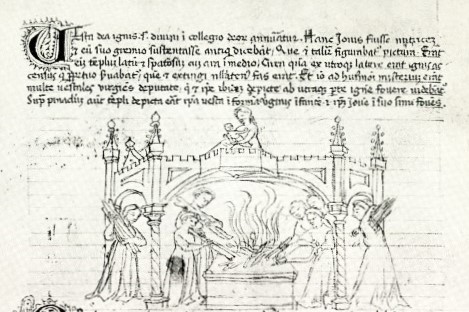
Although Vulcan has a fire, too.
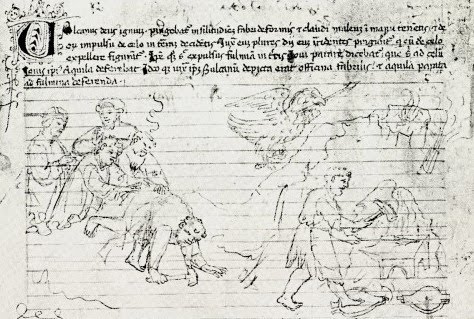
With that I will move on to the other Vatican manuscript, Vat. cod. Palat. 1066, which I am not quite done with. Perhaps there will be something in the rest of it that will stimulate someone's else's thinking.
First, in the event that I have made transcription mistakes regarding the verses discussed in my previous post, I post here a scan of p. 116 of Liebeschutz, which has all of them except the five that are embedded in the Fulgentius Metaforalis text.
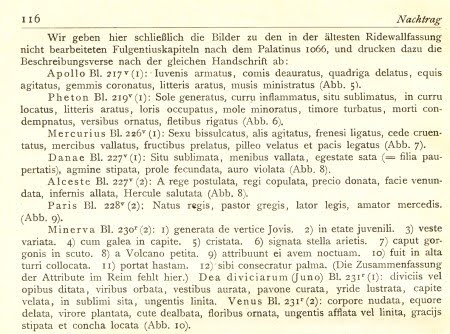
Now on to the virtues and vices. I should perhaps mention beforehand that virtues and vices also get attached to the characters discussed previously (from Liebeschutz's table on p. 56). I am not sure where in the manuscript these are, as I find no discussion of these correspondences in the text.
In the list that follows, the remarks in the parentheses are mine, meant as translations, with some help from Seznec.
Now I will continue with the illustrations.
After the gods and legendary figures, the illustrations to ms. Palat. 1066 move on to the virtues and vices. De Rola's "alchemical" presentation only shows us one of them, f. 239r. I will consider them one by one in order.
The first--the 11th of the whole series-- is f. 232v. It is new to us; it shows Prudencia on top, Judicia and Fortitudo on the bottom. The image of Prudencia is a bearded male on a journey, with his horse behind. I am reminded of the tarot Hermit, and also Saturn as prudence. It at least shows that Prudence didn't have to be a woman with a mirror. The chess pattern behind him is nice. Justicia is apparently deciding between two lawyers--typical of judges, but not of her usual representation. Fortitudo seems to be grabbing the mouth of his mount, in the way that the tarot lady grabs her lion's mouth. It is clear that he has tamed the lion and is not intending to kill it.
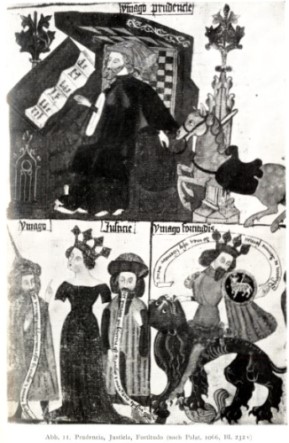
The Latin descriptions that Liebeschutz provides (p. 56) may be of some help, although I can't make much sense out of them. They are in lieu of verses. They come from somewhere in the manuscript, I think as captions to the illustrations, as opposed to the text itself. Liebeschutz's heading for this appendix to his introductory essay is
He is referring to an Excursus that starts on p. 115. The images (Abbildungen) follow p. 116.
For these three first virtues, we read
Justice accordingly ... is depicted as : a girl erect in heaven.
Fortitude accordingly is depicted as king crowned and laureated riding a lion ... horse.
This tells us nothing we didn't already know, except possibly to clarify that the man at the top is a philosopher.
In case I have made mistakes in transcription, and to relieve me of the task of transcribing the descriptions that seem to me of no interest, I reproduce here the entire page of descriptions for the images I am discussing in this post.

The twelfth, f. 235v, is Justice plus Sapiencia three times (at left below). Justicia here has a square edge instead of scales. I have not seen that before; perhaps it represents the "rightness" of a right angle, and the squareness of her dealing. I do not understand the first image of Sapiencia: is it a scene of childbirth? The second Sapiencia, pointing at a book, is reminiscent of the Popess.
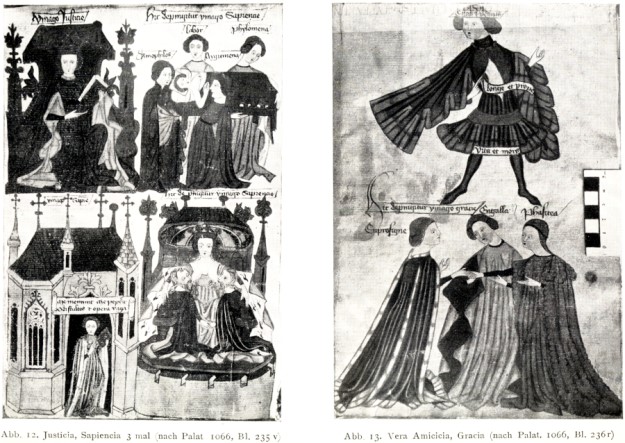
The third Sapiencia is exactly like Sapienta's representation in the alchemical [ii]Aurora Consurgens[/i] of c. 1400 (below). The vat-like structure they are sitting on looks alchemical, too.
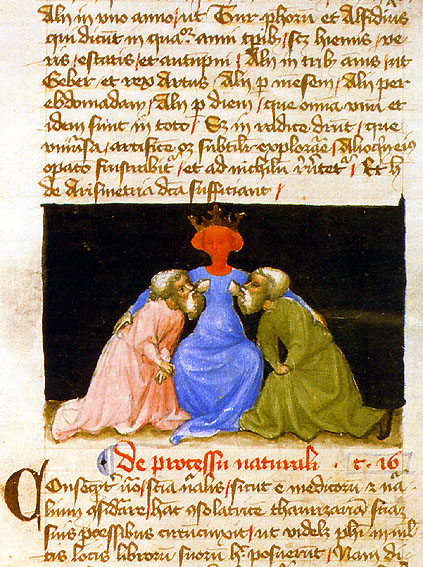
The Latin description of f. 235v is as follows, although I don't find it much help:
The thirteenth, f. 236r (at right above), has Vera Amicicia (true friendship) and Gracia, i.e. the three Graces. Nothing alchemical comes to mind for me.
The fourteenth, f. 236v (at left below), is Fortuna, according to the writing. With peacocks and chariot, she looks more like Juno.
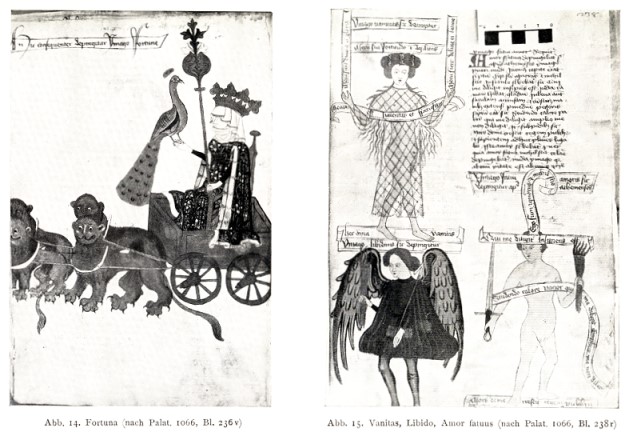
The fifteenth, f. 238r (at right above), is supposedly of Vanitas (vanity), Libido (desire), and Amor fatuus (foolish love). I wish I knew the colors; they might be the white, black, and red of alchemy. I haven't seen such images elsewhere.
The sixteenth, f. 238v, is Amor verus, true love (below). The description says
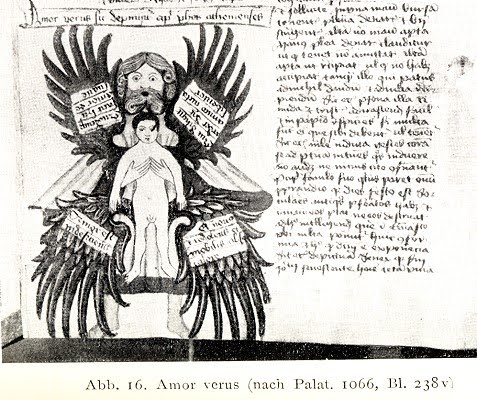
It reminds me of the Lambsprinck (1625) illustrations of the King and the King's son, emblems 11 and 13. Or rather, Lambsprinck might be giving the negative side of protection, which leads to transformation.
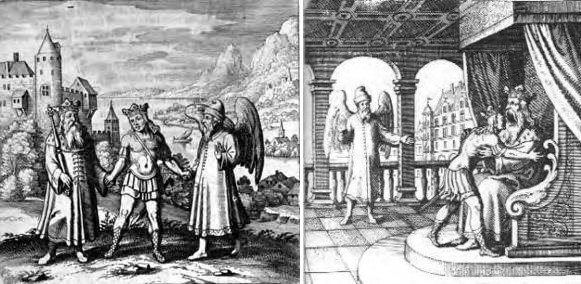
I am also reminded of the Lambsprinck verse that goes with 13 (verse and images from http://www.rexresearch.com/lambspr/lambsp.htm):
These are all apt expressions of the Emperor card in tarot.
We have already seen the seventeenth, f. 239r; I reproduce de Rola's image, which is in color. On top is what de Rola said was eight sublimations. According to Liebeschutz and what is written on the illumination, it is Cupiditas, i.e. overweening desire.
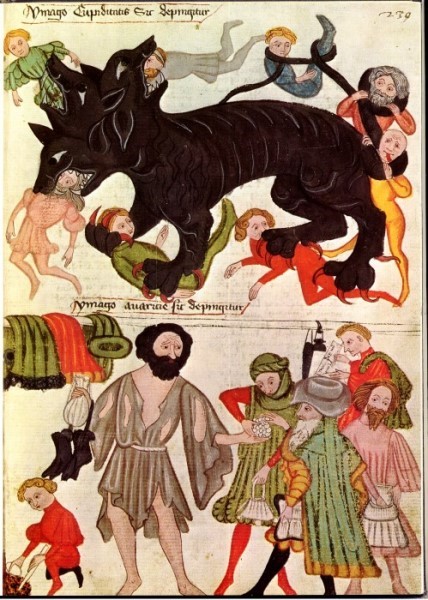
On the bottom is Avaricia, again as is plainly written.
The description of Cupiditas starts with a summary of the general structure of the Fulgentius Metaforalis, that Saturn had four children, Juno, Neptune, Jove, and Pluto (he is ignoring Ceres and Vesta). What is of interest here is Pluto. The text says.
Nothing here about any eight souls to be devoured. It is the same as the number of eagles surrounding Jupiter. De Rola's interpretation makes sense of this correspondence.
Then for Avarice we read:
In other words, it makes him anxious and sad to give up his money to others, even when he has plenty more, so that he spends little on himself. It could also be a picture of the alchemist who has the secret of making gold and silver.
The eighteenth, f. 239v (at left below), is Fortuna, as usually represented. The two faces are unusual but perfectly explicable. So now we have the Wheel of Fortune of the tarot, which I couldn't find before. I see nothing specifically alchemical, although it could represent the ups and downs of the alchemist, the successes and failures, and the repeated sublimations and distillations of the substance, which give it purity.

The nineteenth, f. 241v (at right above) shows Libido (lust), Usuria (masculine despite the feminine name), and Adulacio (feminine despite the masculine name). The first is an unusual scene, but I don't see any relationship to tarot. In alchemy it might represent getting the volatile substance under control, i.e. fixating it. The other would be a danger to be avoided.
In the remaining four pages, I see nothing that I recognize from known alchemical images, and little from tarot. An alchemical interpretation is perhaps possible, but if so I don't know it. 240r has "Superbia, Paciencia, mundana decepcio et fraus." 242v shows "Pietas, summus Deus, Clemencia." 243r has "Cristus, beata Maria, caritas." The last is Terra. Under the picture Liebeschutz has put "234v." that is a misprint for "243v," as may be seen from his page of descriptions (which I put immediately after the pictures). Terra may be the one of these of most interest, since it is one of the elements.
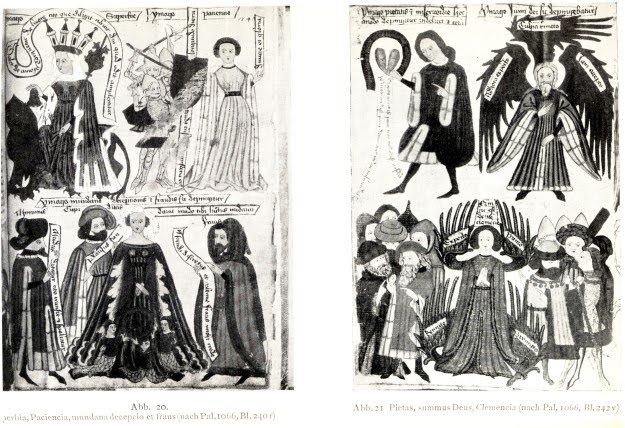
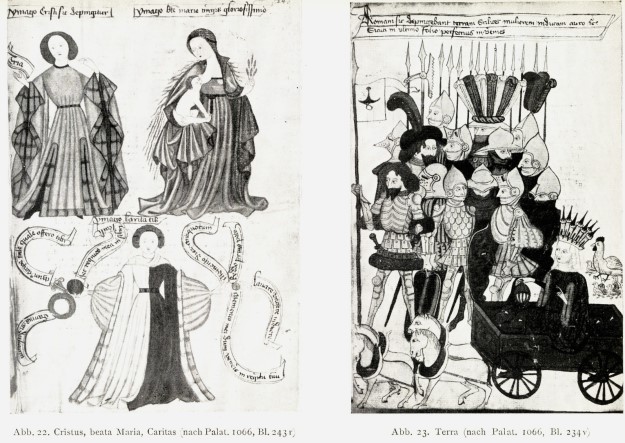
And here, for the sake of completeness, is the corresponding set of descriptions provided by Liebeschutz. Feel free to ignore it, although the one on Terra might be of interest. Terra is the "beata virgine," and perhaps also "caritas," according to the next entry.

Overall, my conclusion is again, for the virtues and vices as much as of the gods and legendary personages, that some of the images show clear alchemical influence and suggest at least how little differentiated the images of the gods/virtues/vices, alchemy, and the soon-to-be tarot were from one another at that time. At the most, they might show, by their very ambiguity, an alchemical tradition for which the artist or patron had some fondness, in which images of an alchemical sequence could be adapted, together with non-alchemical images, to serve as images of the gods and virtues/vices, and also, later, serve again in a card game dressed up now as the road to Christian heaven.
As far as assigning gods to elements, it might help to see how the Libellus assigns them (your "vatican manuscript")--although I don't see where you're going with this issue. (And actually, we have several Vatican manuscripts on this thread, cod. Reg. 1290 and cod. Palat. 1066 being the main ones. Reg. 1290 is the Libellus, which influenced the "tarot of Mantegna" and Lazzarelli. Palat. 1066 is the Fulgentius Metaforalis, with what I found to be unusual illustrations.
Even though the Libellus is in the Fulgentius tradition, it is different. Fortunately, I happen to have the text at hand (less fortunately, it is in Latin). If you want, I can scan the whole thing and post it for you. It's pretty short, 7 scans, plus another 4 for the pictures I have not already posted, and 3 more if Hercules is included. However I think I'd prefer to do it at the beginning of another thread, so it would be easier for other people to notice. This thread is supposedly about a different Vatican manuscript.
For the moment, I will type out the first sentence or so for each of a bunch of gods. I don't know Latin, so I looked for occurrences of "ignis," "aqua," "terra" and "aer." Here is what I saw (the headings, I think, were added by Liebeschutz). I will go in reverse order, because I think he put the best last:
Offhand, I would say Jupiter, Vesta, and Vulcan get fire. Neptune gets water. Juno gets air. Cybele and maybe Pluto get earth. Jupiter also gets the "celum," i.e. "caelum," heaven, which might correspond to the quintessence. [Added next day: or better, aether; see my next post.]XVII VESTA. UEsta, dea ignis, scilicet divini, in collegio deorum annumeratur...
XVI. NEPTUNUS. NEptunus, deus aquarum et precipue maris, depingebatur ad modum cuisdam numinis mare gubernantis....
XV. VULCAN. UUlcanus, deus ignium, pingebatur in similituinem fabri deformis et claudi, maleum in manu tenetis et deorum impulsu de celo in terram decidentis...
XII. CYBELE. CIbelles, mater deorum, fuit dicta terra, quam et deos genuisse dixerunt veteres et Gigantes....
XI. JUNO. JUno posita est in simulitudinem aeris. Antiqui enim ipsam Jovis, id est ignis, uxorem et sororem dixerunt, yridem et nimphas eidem attribuerunt...
X. PLUTO. PLuto, filius Saturni, dictus est ab antiquis deus inferorum et regnorum terrarum et animarum iuste decedentium. Credebant enim antiqui omnes animas ad inferos descendere ibique cum Plutone in caligine perpetua remanere....
II. JUPITER. JUpiter, Saturni filius, celum et celi regnum cui in sortem cessit, pingebatur in throno eburneo in sua maestatis sede sedens, sceptrumque regium in manu tenens, scilicet in sinistra...(Hans Liebeschutz, Fulgentius Metaforalis: Ein Beitrag zur Geschichte der Antiken Mythologie im Mittelelalter, pp. 117-123)
There is this, for Vesta. None of the other gods have such a big fire as this one.

Although Vulcan has a fire, too.

With that I will move on to the other Vatican manuscript, Vat. cod. Palat. 1066, which I am not quite done with. Perhaps there will be something in the rest of it that will stimulate someone's else's thinking.
First, in the event that I have made transcription mistakes regarding the verses discussed in my previous post, I post here a scan of p. 116 of Liebeschutz, which has all of them except the five that are embedded in the Fulgentius Metaforalis text.

Now on to the virtues and vices. I should perhaps mention beforehand that virtues and vices also get attached to the characters discussed previously (from Liebeschutz's table on p. 56). I am not sure where in the manuscript these are, as I find no discussion of these correspondences in the text.
In the list that follows, the remarks in the parentheses are mine, meant as translations, with some help from Seznec.
Then below this list Liebeschutz hasApollo veritas [truth], Phaeton ambicio [ambition], Pluto prudencia rer. fut. [toward the future], Neptunus secunda pars prud. [toward the present], Juno memoria, Jupiter amor et benev., Saturnus prudentia, Mercurius eloquenc., Danae pudicicia [modesty], Alceste continenc. conj. (maarital continence], Paris injusticia, Minerva vita contempl. [contemplative life], Dea divic. [Juno] vita act. [active life], Venus luxuria [lust].
I am not sure where the 22 chapters are.Expliciunt ymagines secundum Fulgencium,. Sequuntur ymagines quatuor virtutum cardinalium secundum diversos doctores et primo de ymagine prudencie." And below that, "es folgen daruber 5 Kapitel und nach einem weiteren Einschnitt: alle ymagines secundum diversos auctores mit 22 Kapiteln siehe auch Anmerkung.
Now I will continue with the illustrations.
After the gods and legendary figures, the illustrations to ms. Palat. 1066 move on to the virtues and vices. De Rola's "alchemical" presentation only shows us one of them, f. 239r. I will consider them one by one in order.
The first--the 11th of the whole series-- is f. 232v. It is new to us; it shows Prudencia on top, Judicia and Fortitudo on the bottom. The image of Prudencia is a bearded male on a journey, with his horse behind. I am reminded of the tarot Hermit, and also Saturn as prudence. It at least shows that Prudence didn't have to be a woman with a mirror. The chess pattern behind him is nice. Justicia is apparently deciding between two lawyers--typical of judges, but not of her usual representation. Fortitudo seems to be grabbing the mouth of his mount, in the way that the tarot lady grabs her lion's mouth. It is clear that he has tamed the lion and is not intending to kill it.

The Latin descriptions that Liebeschutz provides (p. 56) may be of some help, although I can't make much sense out of them. They are in lieu of verses. They come from somewhere in the manuscript, I think as captions to the illustrations, as opposed to the text itself. Liebeschutz's heading for this appendix to his introductory essay is
Die Tugendbildbeschreibungen ersheinen im Palatinus 1066 mit folgenden Kapiteln (die Abbildungen siehe zu S. 115).
He is referring to an Excursus that starts on p. 115. The images (Abbildungen) follow p. 116.
For these three first virtues, we read
My stab at translation: Prudence accordingly in some direction is depicted in the statue of whom philosopher.Bl. 231v:Prudencia secundum aliquos depingitur in statu cuiusdam philosophi. Abb. 11
Bl. 232r: Iusticia secundum dominum Albertum sic depingitur: puella erecta in celum. Abb. 11.
Bl. 233v: Fortitudo secundum aliquos figuratur ad modum regis coronati et laureati equitantis leonem ut equum. Abb. 11.
Justice accordingly ... is depicted as : a girl erect in heaven.
Fortitude accordingly is depicted as king crowned and laureated riding a lion ... horse.
This tells us nothing we didn't already know, except possibly to clarify that the man at the top is a philosopher.
In case I have made mistakes in transcription, and to relieve me of the task of transcribing the descriptions that seem to me of no interest, I reproduce here the entire page of descriptions for the images I am discussing in this post.

The twelfth, f. 235v, is Justice plus Sapiencia three times (at left below). Justicia here has a square edge instead of scales. I have not seen that before; perhaps it represents the "rightness" of a right angle, and the squareness of her dealing. I do not understand the first image of Sapiencia: is it a scene of childbirth? The second Sapiencia, pointing at a book, is reminiscent of the Popess.

The third Sapiencia is exactly like Sapienta's representation in the alchemical [ii]Aurora Consurgens[/i] of c. 1400 (below). The vat-like structure they are sitting on looks alchemical, too.

The Latin description of f. 235v is as follows, although I don't find it much help:
I think it says that the images of Sapiencia are according to diverse wise men. And the depiction of sapiencia as triple comes from someone called William of Aragon, following the Athenians.Iusticia secundum aliquos describitur habere vultum virgineum, aureum vel vitreum.
Explicunt ymagines quatuor virtutum cardinalium: incipiunt alie ymagines secundum divorsos doctores et primo de ymagine sapiencie iuxta precedencia depicta. Narrat magister Guillelmus Aragoniensis quod Athenienses tripliciter descripserunt sapienciam.
The thirteenth, f. 236r (at right above), has Vera Amicicia (true friendship) and Gracia, i.e. the three Graces. Nothing alchemical comes to mind for me.
The fourteenth, f. 236v (at left below), is Fortuna, according to the writing. With peacocks and chariot, she looks more like Juno.

The fifteenth, f. 238r (at right above), is supposedly of Vanitas (vanity), Libido (desire), and Amor fatuus (foolish love). I wish I knew the colors; they might be the white, black, and red of alchemy. I haven't seen such images elsewhere.
The sixteenth, f. 238v, is Amor verus, true love (below). The description says
I think it means, "There follows the image of true love. True love according to the Athenian philosophers was like this: protect a boy with four wings."Sequitur amoris veri ymago. Amor verus apud Athenienses philosophos depingebatur sic: protegns unum puerum cum quatuor alis.

It reminds me of the Lambsprinck (1625) illustrations of the King and the King's son, emblems 11 and 13. Or rather, Lambsprinck might be giving the negative side of protection, which leads to transformation.

I am also reminded of the Lambsprinck verse that goes with 13 (verse and images from http://www.rexresearch.com/lambspr/lambsp.htm):
My Son, I was dead without thee,
And lived in great danger of my life.
I revive at thy return,
And it fills my breast with joy.
But when the Son entered the Father's house,
The Father took him to his heart,
And swallowed him out of excessive joy,
And that with his own mouth.
The great exertion makes the Father sweat.
These are all apt expressions of the Emperor card in tarot.
We have already seen the seventeenth, f. 239r; I reproduce de Rola's image, which is in color. On top is what de Rola said was eight sublimations. According to Liebeschutz and what is written on the illumination, it is Cupiditas, i.e. overweening desire.

On the bottom is Avaricia, again as is plainly written.
The description of Cupiditas starts with a summary of the general structure of the Fulgentius Metaforalis, that Saturn had four children, Juno, Neptune, Jove, and Pluto (he is ignoring Ceres and Vesta). What is of interest here is Pluto. The text says.
My approximation: Pluto is rich, because "Pluto" means "rich." He is the god of what is below; below he devours many, it is said. At the foot is imposed Cerberus, the infernal dog who is called doorkeeper below, whence understanding Cupidity itself. This Cerberus, this infernal dog, according to Boethius and Ovid, is a horrible dog and has three heads and a serpent's tail.Pluto est dives, quia Pluto dives interpretatur. Item est deus inferni; infernus enim multos devorat, iunde ditator; sub pedibus eius ponitur Cerberus tamquam canis inferni et dicitur janitor inferni, unde per ipsum cupidtatem intelligunt. Iste Cerberus, id est canis inferni, sic depingitur, quia, ut tangit Boecius et Ovidius, est ut canis horribilis et habet tria capita et caudam serpentinam.
Nothing here about any eight souls to be devoured. It is the same as the number of eagles surrounding Jupiter. De Rola's interpretation makes sense of this correspondence.
Then for Avarice we read:
My guess: Avarice accordingly is like a person who thinks profoundly, melancholy and anxious, who in one hand holds a purse full of coins and well tied, the other hand indeed is open.Avaricia sic depingitur secundum aliquos in similitudine unius persone cogitantis profunde, melancolice et sollicite, in una manu bursam tenentis plenam denariis et bene stringentis, Albera vero manu apperta.
In other words, it makes him anxious and sad to give up his money to others, even when he has plenty more, so that he spends little on himself. It could also be a picture of the alchemist who has the secret of making gold and silver.
The eighteenth, f. 239v (at left below), is Fortuna, as usually represented. The two faces are unusual but perfectly explicable. So now we have the Wheel of Fortune of the tarot, which I couldn't find before. I see nothing specifically alchemical, although it could represent the ups and downs of the alchemist, the successes and failures, and the repeated sublimations and distillations of the substance, which give it purity.

The nineteenth, f. 241v (at right above) shows Libido (lust), Usuria (masculine despite the feminine name), and Adulacio (feminine despite the masculine name). The first is an unusual scene, but I don't see any relationship to tarot. In alchemy it might represent getting the volatile substance under control, i.e. fixating it. The other would be a danger to be avoided.
In the remaining four pages, I see nothing that I recognize from known alchemical images, and little from tarot. An alchemical interpretation is perhaps possible, but if so I don't know it. 240r has "Superbia, Paciencia, mundana decepcio et fraus." 242v shows "Pietas, summus Deus, Clemencia." 243r has "Cristus, beata Maria, caritas." The last is Terra. Under the picture Liebeschutz has put "234v." that is a misprint for "243v," as may be seen from his page of descriptions (which I put immediately after the pictures). Terra may be the one of these of most interest, since it is one of the elements.


And here, for the sake of completeness, is the corresponding set of descriptions provided by Liebeschutz. Feel free to ignore it, although the one on Terra might be of interest. Terra is the "beata virgine," and perhaps also "caritas," according to the next entry.

Overall, my conclusion is again, for the virtues and vices as much as of the gods and legendary personages, that some of the images show clear alchemical influence and suggest at least how little differentiated the images of the gods/virtues/vices, alchemy, and the soon-to-be tarot were from one another at that time. At the most, they might show, by their very ambiguity, an alchemical tradition for which the artist or patron had some fondness, in which images of an alchemical sequence could be adapted, together with non-alchemical images, to serve as images of the gods and virtues/vices, and also, later, serve again in a card game dressed up now as the road to Christian heaven.
Last edited by mikeh on 16 Feb 2011, 19:51, edited 1 time in total.
Re: Tarot-like images in a c.1420 manuscript
15On the correspondences between gods and elements, there is also Martianus Capella (for which, in the Urbino manuscript, "Mantegna" illustrations of the liberal arts were used). Fulgentius was commenting on him; and after Fulgentius came the influential Carolingian Remigius. Here are some quotes from the section of Liebeschutz's book on Remigius ("Gotterdarstellungen bei Remigius," pp. 44-45 of his Beitrag]/i]). I apologize for omitting the umlauts, not on my keyboard:
So we see Jupiter associated with the ether. I hadn't been aware that Diana was associated with earth.
I don't believe Remigius is available in translation. Martianus is, although I can't find his "Marriage of Philology and Mercury" in Google Books. I will have to go to the library.
Jupiter erscheint als der umfassende Allgot, der sich unter den Namen der verschidensten Gotter und Gottinnen verbirgt (70r): Quia philosophi unum deum dicunt esse celi et terre rerumque omnium conditorem, quia pro multiplicia dispositione qua mundum variis modis regit, diversis appellatur vocabulis; enim vizonis, quod vitam praestet, sentinus, quod sensum, vocatur Jovis in aethere, Juno in aere, Diana in terra, multaque aliea nomina sun deorum; plerumue unus idemque non solum diversis nominibus, set et vario sexu appellatur...Im allgemeinen ist Jupiter die Verkorperung der Atherzone gegenuber dem drunter liegenden Bereich, der Juno eigen ist.
Juno in ihrem Glanz is dem neben ihr thronenden Bruder ahnlich nur wird ihre Heiterkeit zuweilen getrubt (Marts. 20, 6/9). Dazu gift Remigius die naturliche Erklarung (76v): Aer enim serenus pene similis est claitati etherie, nisi quod ille id est ether resplendebat immutabili Iaeticia, quod aether atherica luce splendet et nullis nubibus obsuratur...Juno, aer videlicet, concutitur, id est perturbatur nubilo assiduarum perturbationum. Aer enim crebro ventis et turbinibus concutitur...Nam Jovis ipse est aether, Juno vero aer. Cum ergo terra marcescentibus hieme seminibus suis solitum exposcat a Jove, id est ab aetherio igne, fomitum, non aliter tamen hac bene fieri potest, nisi intercedente et quasi mediante Junone, id est aere, quae calorem aetherii ignis suscipiens terre solitam affert fecunditatem.
...
Bei der Zusammenstellung von Meer und Neptun ist naturliche und moralische Detung verbunden (81 v zu Mar. 23, 9)...
Vulcanus bezeichnet das Element des Feuers; er wird dabei mit dem Herrn des Athers zusammengestellt (83r zu Mar. 24, 7) qui secundum fabulam de caelo a Jove projectus in Lemnum insulam cecidit, sique claudus factus est quod ideo fingitur, quod Ignis nunquam rectus incredit sed flexuosus et anfractuosus...Dicus tamen est ab Eraclito ligator sive formator tocius mundi. Nihil enim omnibus creaturis sine igne constat. Unde et Eracltus ex igne dicit omnia constare. Inter Jovem, Vulcanum et Vestam hoc distat, quod Jupiter id est aetherius (83v) ignis, simplex et innocuus nihilque perurens; Vulcanus vero intelligitur noxiius ignis et urens, qualis est fulminum. Unde Vulcanus quasi Volicanus id est volans cndor interpretatur. Vesta vero est ignis, que usibus et utilitatibus mortalium accomodatur. ...
So we see Jupiter associated with the ether. I hadn't been aware that Diana was associated with earth.
I don't believe Remigius is available in translation. Martianus is, although I can't find his "Marriage of Philology and Mercury" in Google Books. I will have to go to the library.
Re: Tarot-like images in a c.1420 manuscript
16Fighting through the stories of some older popes, I detected a Portuguese Pope John XXI in the years 1276-77 ...
http://en.wikipedia.org/wiki/Pope_John_XXI
... before called Pedro Hispano.
http://en.wikipedia.org/wiki/Gunpowder
http://en.wikipedia.org/wiki/Pope_John_XXI
... before called Pedro Hispano.
"Laboratory" and "it collapsed" and contact to "Tatars" make me think about early gunpowder experiments, a possibility, which we earlier discussed here.After the death of Pope Adrian V, on August 18, 1276, Pedro Hispano was elected Pope at the conclave of cardinals on September 13, and he was crowned a week later. One of John XXI's few acts during his brief rule was to reverse the decree recently passed at the Second Council of Lyon (1274), which not only confined cardinals in solitude until they elected a successor Pope, but also progressively restricted their supplies of food and wine if their deliberation took too long.
Though much of John XXI's brief papacy was dominated by the powerful Cardinal Giovanni Gaetano Orsini (who succeeded him as Pope Nicholas III), John attempted to launch a crusade for the Holy Land, pushed for a union with the Eastern church, and did what he could to maintain peace between the Christian nations. He also launched a drive to convert the Tatars, which came to nothing.
To secure the necessary quiet for his medicine studies [he was also a physician], he had an apartment [other sources speak of a laboratory] added to the papal palace at Viterbo, to which he could retire when he wished to work undisturbed. On 14 May 1277, while the pope was alone in this apartment, it collapsed; John was buried under the ruins, and died on 20 May in consequence of the serious injuries he had received. He was buried in the Duomo di Viterbo where his tomb can still be seen.
After his death, it was rumored that John XXI had actually been a magician (a suspicion frequently directed towards the preciously few scholars among medieval popes even during their papacy; cf. Sylvester II), and that he was writing a heretical treatise in the room that collapsed on him, by an Act of God, it was inferred.[1]
In The Divine Comedy Dante sees John XXI (referred to as "Pietro Spano") in the Heaven of the Sun with the other spirits of great religious scholars.
http://en.wikipedia.org/wiki/Gunpowder
It would be relative contemporary to other sources.C. F. Temler interprets Peter, Bishop of Leon, as reporting the use of cannon in Seville in 1248.
In Europe, one of first mentions of gunpowder use appears in a passage found in Roger Bacon's Opus Maius and Opus Tertium in what has been interpreted as being firecrackers. The most telling passage reads: "We have an example of these things (that act on the senses) in [the sound and fire of] that children's toy which is made in many [diverse] parts of the world; i.e. a device no bigger than one's thumb. From the violence of that salt called saltpetre [together with sulphur and willow charcoal, combined into a powder] so horrible a sound is made by the bursting of a thing so small, no more than a bit of parchment [containing it], that we find [the ear assaulted by a noise] exceeding the roar of strong thunder, and a flash brighter than the most brilliant lightning."
...
The Liber Ignium, or Book of Fires, attributed to Marcus Graecus, is a collection of incendiary recipes, including some gunpowder recipes. Partington dates the gunpowder recipes to approximately 1300. One recipe for "flying fire" (ingis volatilis) involves saltpetre, sulfur, and colophonium, which, when inserted into a reed or hollow wood, "flies away suddenly and burns up everything." Another recipe, for artificial "thunder", specifies a mixture of one pound native sulfur, two pounds linden or willow charcoal, and six pounds of saltpeter. Another specifies a 1:3:9 ratio.
Some of the gunpowder recipes of De Mirabilibus Mundi of Albertus Magnus are identical to the recipes of the Liber Ignium, and according to Partington, "may have been taken from that work, rather than conversely." Partington suggests that some of the book may have been compiled by Albert's students, "but since it is found in thirteenth century manuscripts, it may well be by Albert." Albertus Magnus died in 1280.
Huck
http://trionfi.com
http://trionfi.com
